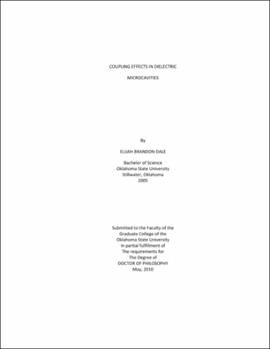| dc.contributor.advisor | Rosenberger, Albert T. | |
| dc.contributor.author | Dale, Elijah Brandon | |
| dc.date.accessioned | 2013-11-26T08:26:30Z | |
| dc.date.available | 2013-11-26T08:26:30Z | |
| dc.date.issued | 2010-05 | |
| dc.identifier.uri | https://hdl.handle.net/11244/6881 | |
| dc.description.abstract | Scope and Method of Study: The simple four-mirror ring cavity model of microsphere resonances is extended to include internal polarization coupling and dual-cavity coupling. This model is extended into the time domain allowing measurement of the cavity quality factor and coupling regime using phase sensitive cavity ringdown. Coupled-mode theory is numerically employed to characterize the strength of dual-cavity coupling and direct polarization coupling between fiber and microsphere modes. Furthermore, the microsphere's evanescent field has been enhanced by applying gold nanorods grown in solution directly on the cavity surface. These enhanced resonators are used to demonstrate sensing enhancement and all optical coupling control. | |
| dc.description.abstract | Findings and Conclusions: Time domain phase sensitive cavity ringdown on the through signal is used to show that modal dephasing is below measuremental uncertainty. The calculation of dual sphere coupling predicts that the peak coupling strength is slightly greater than fiber-microsphere coupling and will occur between fundamental cavity modes. It is found that mode phase matching dominates radial mode order coupling while spatial overlap dominates polar mode order coupling. Nanowires, grown from solution, have been grown with aspect ratios in excess of 1000. These wires have been placed directly on the microsphere and used to demonstrate the localization of evanescent field enhancement. Gold nanorods grown in solution have been directly adhered to the cavity surface allowing control of plasmonic character while still in solution. These enhanced cavities have been shown to exhibit similar levels of coupling enhancement at wavelengths of 800 nm to surface grown nanorods (~300) and much larger enhancement at wavelengths of 1550 nm (~1500). These enhanced cavities have been shown to increase sensitivity of traveling wave evanescent sensors. They have also been shown to produce surface enhanced Raman scattering, which has the potential to demonstrate species identification. Optical control of plasmonic enhancement has been demonstrated and used to control the observable dip-depth of the cavity resonance. Finally, internal polarization coupling between orthogonal cavity modes has been observed and understood from a modified ring cavity scattering model; the results are in good agreement with experiment. | |
| dc.format | application/pdf | |
| dc.language | en_US | |
| dc.rights | Copyright is held by the author who has granted the Oklahoma State University Library the non-exclusive right to share this material in its institutional repository. Contact Digital Library Services at lib-dls@okstate.edu or 405-744-9161 for the permission policy on the use, reproduction or distribution of this material. | |
| dc.title | Coupling effects in dielectric microcavities | |
| dc.contributor.committeeMember | Bandy, Donna K. | |
| dc.contributor.committeeMember | Agarwal, Girish S. | |
| dc.contributor.committeeMember | Ackerson, Bruce J. | |
| dc.contributor.committeeMember | Yukihara, Eduardo G. | |
| dc.contributor.committeeMember | Grischkowshy, Daniel R. | |
| osu.filename | Dale_okstate_0664D_10793.pdf | |
| osu.accesstype | Open Access | |
| dc.type.genre | Dissertation | |
| dc.type.material | Text | |
| thesis.degree.discipline | Physics | |
| thesis.degree.grantor | Oklahoma State University | |
